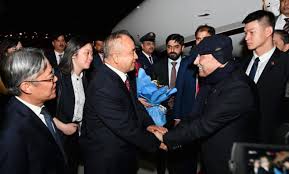Italy set to produce next-gen GCAP fighters in own factory

Rome: Italy is taking a major step in its defense strategy by announcing plans to build its own factory for the production of next-generation GCAP [Global Combat Air Program] fighter jets. The move signals not only Italy’s ambition to lead in aerospace technology but also a shift toward greater self-reliance in military aviation.
Italy has successfully secured a deal to establish a new fighter jet production facility, placing Rome firmly at the center of Europe’s aerospace industry. This ambitious move positions Italy as the key player in the continent’s military aircraft manufacturing, especially as the country has already been an active participant in the production of the F-35.
With the new factory, Italy became the only European nation capable of manufacturing both 5th and 6th-generation fighter jets, a distinction that sets it apart from other European powers.

Final confirmation that Italy 🇮🇹 will host its own factory for the production of the 6th Gen. GCAP fighter.
Reports indicate that Italy is set to overtake the UK in Eurofighter Typhoon production, with the new plant expected to ramp up output to as many as 90 to 100 jets per year. This marks a significant shift in Europe’s defense and aerospace industry, as Italy consolidates its position as a leading manufacturer of advanced fighter jets.
The decision to increase its production capabilities in this manner is not a coincidence. Italy’s extensive involvement in the F-35 program has allowed its engineers and aerospace experts to gain invaluable hands-on experience with the complex systems required to build and assemble such advanced aircraft.
This experience has paved the way for Italy to handle the production of next-generation fighters, putting it ahead of the UK and Japan—two other participants in the GCAP program.
The new factory, slated to be built in Piemonte, represents a highly strategic decision. This region, with its advanced industrial base and proximity to key military infrastructure, makes it an ideal location for such a critical defense project.
The move not only strengthens Italy’s military capabilities but also enhances its strategic importance within Europe and NATO, particularly at a time when tensions with Russia and other global security challenges are rising.
The GCAP program, a joint venture between Italy, the UK, and Japan, is designed to deliver a cutting-edge multi-role fighter that will replace aging fleets across the three nations. With this new production facility, Italy will assume a key role in manufacturing the next-generation stealth fighter, which is expected to feature advanced sensors, superior stealth capabilities, and unprecedented interoperability with unmanned aerial systems.
This development isn’t just a boost to Italy’s aerospace capabilities—it’s a strategic play that will redefine Europe’s defense posture. The decision to build the factory domestically allows Italy to maintain full control over the production process, which could offer significant advantages in terms of flexibility and national security. It also positions Italy as a crucial player in the future of international air defense.
By securing domestic production, Italy ensures that it won’t rely on foreign manufacturers for critical defense technology. As global security tensions rise, especially in the face of advanced air threats, Italy’s move is seen as vital for ensuring the country’s air force remains modern, agile, and ready for the future.
The factory’s construction is set to create thousands of jobs, providing a major economic boost. With new opportunities in engineering, manufacturing, and research, Italy’s aerospace sector will become even more competitive on the global stage. The GCAP project is likely to attract further investments and foster collaborations with international defense suppliers.
Moreover, the factory will play a significant role in enhancing NATO’s collective defense. Italy’s contribution to the GCAP program aligns with its broader commitment to bolster European security, especially as tensions with Russia and other global challenges continue to escalate.
With other nations like the U.S. and China also pushing the boundaries of fighter jet technology, the GCAP fighter is positioned to be a crucial asset for Italy’s military. The joint collaboration will ensure that the new fighter can compete on a global scale, integrating the latest in stealth, avionics, and weapon systems.
For Italy, this means a more secure future in a rapidly changing world, with the ability to project power not just regionally but globally. The country’s defense capabilities will be significantly enhanced, giving it the tools to respond to emerging threats more effectively.
The establishment of the new GCAP production facility is just the beginning. As the program moves forward, Italy’s defense industry will continue to evolve, possibly incorporating even more advanced technologies such as AI-driven combat systems and next-gen cyber defense mechanisms. The nation is positioning itself at the cutting edge of modern military aviation—ready to meet the challenges of the future head-on.
GCAP [Global Combat Air Program] is expected to be a next-generation fighter jet that will combine a range of innovations and advanced technologies, making it a key component in the defense strategies of the participating countries.
It will feature enhanced stealth capabilities, allowing it to operate in heavily defended airspaces without being easily detected by radars and other air defense systems. This will make it highly effective in various combat scenarios, including high-intensity conflicts.
The fighter will be equipped with powerful sensors and avionics systems that will allow it to gather and process real-time data, as well as provide high-efficiency interaction with other platforms, including unmanned aerial vehicles [UAVs]. This will ensure the full integration of GCAP into modern networked combat systems, which is crucial for the future of air operations.
GCAP will be designed with flexibility in mind, capable of performing a wide range of missions—from air superiority and close air support to deep strikes against strategic targets at long distances.
This will be made possible by its advanced weapon systems, which will include not only sophisticated missiles and bombs but also the capability to operate in various environments, from maritime to land-based combat.
Additionally, GCAP will feature adaptive and autonomous technologies that will allow it to perform tasks and make decisions without constant pilot control. This will increase its capacity to conduct operations in dangerous and challenging conditions, while simultaneously providing the pilot with the support needed to optimize decisions in dynamic situations.
Among the expected characteristics is its ability to integrate into multinational operations, thanks to its compatibility with the other partners in the program, including the UK and Japan. This will allow GCAP to be part of joint missions and operate effectively within allied networks for information and resource sharing.
The UK, Japan, and Italy have officially joined forces to develop the next-generation “sixth-generation” fighter aircraft through a newly formed joint venture [JV], marking a pivotal moment in the Global Combat Air Programme [GCAP].
With each partner — BAE Systems, Japan Aircraft Industrial Enhancement Co. Ltd [JAIEC], and Leonardo — holding an equal stake, the JV is poised to deliver a cutting-edge fighter by the mid-2030s.
The agreement, finalized on December 13, now awaits approval from national regulatory bodies before the JV is fully operational in mid-2025. This new venture will lead the design, development, and delivery of the advanced fighter, which is expected to stay relevant well beyond 2070, providing critical air superiority for decades to come.
Strategically, the JV’s headquarters will be located in the UK, ensuring tight integration with the GCAP International Government Organisation [GIGO], also based in the UK. This centralized effort is aimed at maximizing coordination as the nations push forward with one of the most ambitious and technologically advanced fighter programs in history.





